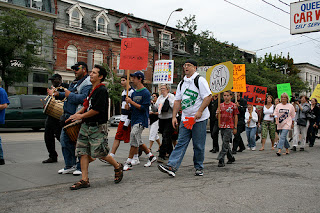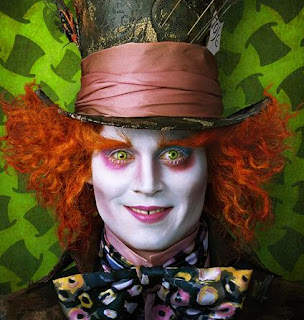Today is the start of Mad Pride week in Toronto, an annual event that began here and has spread around the world, as psychiatric survivors/consumers and their allies challenge the stigma and oppression of those with mental health issues, and celebrate madness.
Psychiatric oppression
With the rise of capitalism, people who could not fit into narrowly-defined norms of labour productivity, either because of physical or psychiatric differences, became pathologized. Since then mad people have been subjected to diverse methods of “restoring sanity,” such as institutionalization, electroshock and “the chemical prison industry” of Big Pharma. In Toronto, those incarcerated at the Provincial Lunatic Asylum (now the Centre for Addiction and Mental Health) were forced to build the walls that surrounded them (a history that psychiatric survivor and York professor Geoffrey Reaume has helped expose).
At the same time, labels of mental illness have been more widely applied to any groups deviating from social norms. In the 1850s slaves who fled their masters were pathologized as suffering from “Drapetomania,” while women who disobeyed their husbands were institutionalized for “hysteria.” Until the 1970s homosexuality was considered a mental illness, and transgender people are still labelled as suffering from a “gender identity disorder.” Dissidents in state capitalist regimes in Russia and China were also labelled mentally ill and institutionalized.
Despite this record, people have often used psychiatric labels as a substitute for political critique, which not only depoliticizes the issues but reinforces the stigma and oppression of mad people. While George Bush was called “crazy” for launching the Iraq War, Obama’s continuation of the war has proven it is not based on psychiatric deviance but on U.S. imperialism. While the Tea Party has been labelled “lunatic,” Jon Stewart’s “Rally to restore sanity” targeted the anti-war left as much as the populist right — proving how psychiatric labels serve to maintain the status quo. This year Libyan dictator Muammar Gaddafi was labelled “insane” as justification for war — erasing the record of Western support and relying on the stigma of madness to justify Western military intervention.
Hollywood often reinforces the stigma of mental illness, with “crazy” villains whose evil is rooted in their psychiatric deviance — from Hitchcock’s Psycho, to Hannibal Lecter, to various Batman villains (all of whom have at one time or another been incarcerated in Arkham Asylum). A noted exception is One Flew Over the Cuckoo’s Nest, which famously depicted some of the repressive conditions of psychiatric institutions. This film was made in 1975, during a rising movement against the oppression of mad people.
Mad Pride
 |
| Toronto Mad Pride, 2007 |
There has been a long history of resistance to psychiatric oppression. In the liberation movements of the 1960s and ’70s there was not only Black Power, Red Power, Women’s Liberation and Gay Liberation, but also the Insane Liberation Front. These days, a Mental Health Consumer/Psychiatric Survivor movement continues to fight against economic and social discrimination, demanding peer-run services, and challenging stigma. This does not mean rejecting medicine like the anti-psychiatry movement, but emphasizing choice and self-determination.
In 1993 Toronto began Mad Pride, which has spread around the world as a “great opportunity to witness the creative potential of madness, as well as learning about the challenges faced by survivors.” As a blogger with mental health issues wrote:
“Mad Pride is a movement quite like Gay Pride, it started from a need for a stigmatized segment of our community to be given respect and equal rights… We need to join the Crazy, the Sane, the lay person and professional to come together to break down the walls of hate, fear, stigma, and stand up for Mad Pride…Because we are all a little mad!”
 Last year there was a rare mainstream film celebrating madness: Tim Burton’s Alice in Wonderland. Besides featuring an empowered, independent female character, the film is also refreshing in how it deals with madness. Through the character of the Mad Hatter, the film treats madness not as deviancy in need of suppression or forced correction, but as a different and legitimate form of expression. When the Mad Hatter worries “Have I gone mad,” Alice reassures him by saying “I’m afraid so. You’re entirely bonkers. But I’ll tell you a secret: all the best people are.” The key to Alice vanquishing the Jaberwocky is her ability to embrace all her experiences that would otherwise be dismissed as “crazy” — a cat that smiles, a rabbit with a watch, etc.
Last year there was a rare mainstream film celebrating madness: Tim Burton’s Alice in Wonderland. Besides featuring an empowered, independent female character, the film is also refreshing in how it deals with madness. Through the character of the Mad Hatter, the film treats madness not as deviancy in need of suppression or forced correction, but as a different and legitimate form of expression. When the Mad Hatter worries “Have I gone mad,” Alice reassures him by saying “I’m afraid so. You’re entirely bonkers. But I’ll tell you a secret: all the best people are.” The key to Alice vanquishing the Jaberwocky is her ability to embrace all her experiences that would otherwise be dismissed as “crazy” — a cat that smiles, a rabbit with a watch, etc.
As we build movements for change, it’s important to challenge all forms of discrimination including psychatric. This means rejecting the derogatory use of “crazy” and “insane,” learning about the history of psychiatric oppression and resistance, building alliances with our mad sisters and brothers, and celebrating Mad Pride.
For a calendar of events for this year’s Mad Pride week in Toronto, visit madpridenetwork.com.



